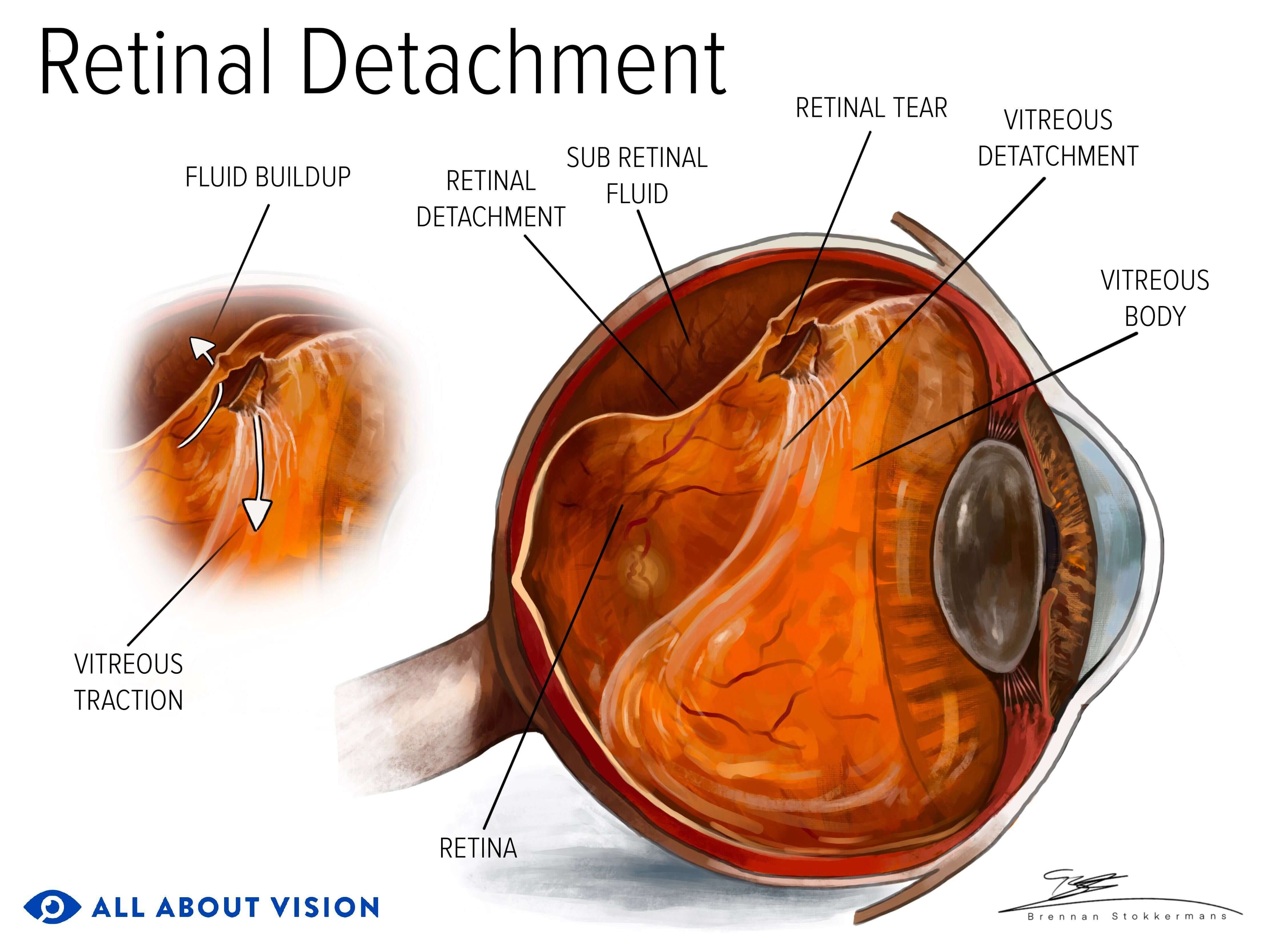Retinal detachment: Symptoms, causes and treatment

A retinal detachment is the separation (detachment) of a portion of the light-sensitive retina from the back of the eyeball. A retinal detachment (or detached retina) is a serious eye condition that is a medical emergency.
If a retinal detachment is not diagnosed and treated promptly, permanent vision loss and even blindness can occur.
When this occurs, the blood supply to the detached retina is cut off, causing the death of specialized cells in the retina that are essential for our sense of sight.
If a retinal detachment is not detected and treated promptly, the retina can continue to tear away from the back of the eye, causing greater and greater vision loss.
READ MORE:
Risk factors
Risk factors for retinal detachment include:
High myopia
Trauma to the head or eyes
Aging (especially after age 50)
Previous eye surgery (including cataract surgery)
Peripheral retinal degeneration
Diabetes and diabetic retinopathy
A family history of detached retina
Retinal detachment can also occur in someone who has none of the risk factors listed above.
Symptoms

Seeing a curtain-like shadow coming down across your field of vision can be a sign of retinal detachment.
Symptoms of a detached retina include:
A sudden increase in eye floaters
The appearance of a dark curtain blocking part of your field of view
Sudden blurred vision in one eye
If you have a sudden onset of any of these symptoms of a detached retina, contact an eye doctor immediately.
READ MORE: Retinal detachment symptoms and warning signs
Causes
Most retinal detachments are caused by a rip or tear in the retina, which often occurs because of traction (pulling) on the surface of the retina.
The risk factors listed above play a significant role in the type of retinal detachment you may experience.
In most cases, this traction is due to the clear, gel-like fluid inside the eye (called the vitreous or vitreous humor) pulling away from its attachment to the front surface of the retina.
Normally, the vitreous (“VI-tree-uhs”) liquifies with age and separates from the retina without causing any problems. Though there may be some tugging on the retina (which causes the symptom of flashing lights), the vitreous eventually works free without damaging the retina.
In some cases, as the vitreous pulls away from the retina, it causes a rip or tear in the retina and pulls the torn retina from the back of the eye.
Retinal detachment can also be caused by the accumulation of fluid under the retina, even if there are no rips or tears in the retinal tissue.
SEE RELATED: Retinal vasculitis
Detection and diagnosis
During a comprehensive eye exam, your optometrist or ophthalmologist will dilate your pupils and closely examine your retinas for signs of detachment.
Your eye doctor also may perform special retinal imaging tests to obtain a full, wide-angle view of the entire retina of both eyes.
If the diagnosis of retinal detachment is made, your eye doctor will then refer you to a specialist for surgical treatment.
If you are experiencing flashes and floaters but your doctor finds no signs of a retinal tear or detachment, you may be asked to return for another exam within a few weeks to make sure no problems have developed. If your symptoms change significantly before your follow-up appointment, be sure to contact your eye doctor immediately.
Treatment
Surgery is required to repair a detached retina. It is also the only treatment for retinal detachment.
The procedure is usually performed by a retina specialist — an ophthalmologist who has undergone advanced training in the medical and surgical treatment of retinal disorders. Generally, the sooner the retina is reattached, the better the chances that vision can be restored.
Surgical procedures used to treat a retinal detachment include:
Scleral buckling surgery
Vitrectomy
Pneumatic retinopexy
If the detachment is caused by a tear in the retina, the surgeon usually uses a laser or a freezing probe to seal the tear and firmly reattach the retina to the back of the eye.
If a laser is used, this is called laser photocoagulation.
If a freezing probe is used, it’s called cryopexy.
READ MORE:
Prevention
Having routine comprehensive eye exams is the best way to prevent retinal detachment and vision loss from a detached retina.
Your eye doctor can spot early warning signs of retinal detachment before you notice symptoms, and may refer you to a retinal specialist for preventive treatment.
Avoiding contact sports that increase your risk of head and eye trauma (such as football and boxing) is one way to reduce your risk of retinal detachment.
You can also ask your eye doctor about myopia control methods. If you can prevent your child from developing a high degree of myopia, you may be able to help prevent retinal detachment.
Though none of these measures will guarantee that you (or your children) will avoid developing a detached retina, they are the best options currently available for preventing retinal detachment.
See an eye doctor
Remember: Retinal detachment is a serious eye condition that can cause permanent vision loss and even blindness.
Don’t take chances with your eyesight. If you experience any symptoms of a potential retinal detachment, see an eye doctor immediately.
Even if you are symptom-free, be sure to have a comprehensive eye exam at least once a year (especially after you turn 50) to assess your risk of a detached retina or other eye conditions that increase with age.
SEE RELATED: Retinal detachment: Frequently asked questions
Page published on Monday, March 4, 2019






